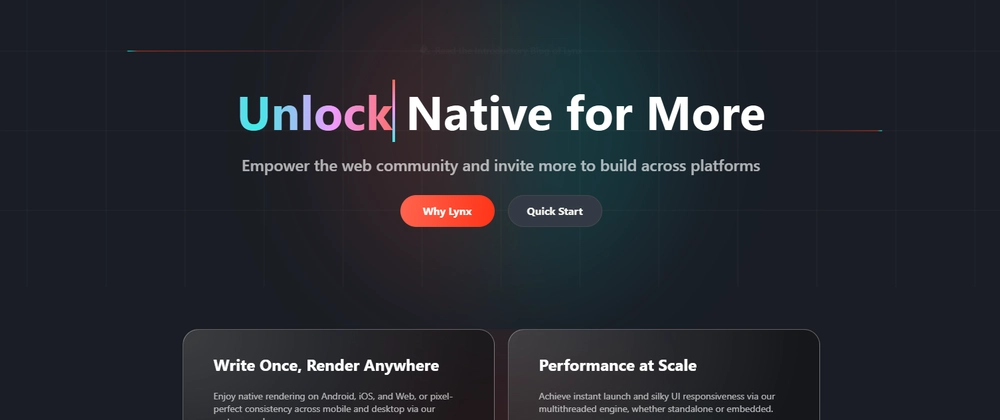Introduction
Imagine developing an app that runs seamlessly on Android, iOS, and the web—without managing multiple codebases or sacrificing performance. Sounds like a dream? Meet Lynx JS, the latest cross-platform JavaScript framework from ByteDance, the company behind TikTok.
Lynx JS is gaining attention for its speed, native-like feel, and web-friendly approach, making it a serious competitor to React Native and Flutter. Let’s break down what makes Lynx JS special and whether it’s the right framework for your next project.
What is Lynx JS?
Lynx JS is a JavaScript-based framework designed to build cross-platform apps using one codebase. Unlike React Native, which relies on a JavaScript bridge, Lynx JS maps directly to native components—resulting in faster load times and smoother performance.
Key Features:
- Web-Friendly Development: Uses CSS, HTML-like tags, and JavaScript, making it easy for web developers to adapt.
- Dual-Threaded Architecture: Separates UI rendering from logic processing, ensuring a lag-free experience.
- Native Rendering: No reliance on web views—Lynx JS renders components directly as native UI elements.
- React-Like Syntax: Supports ReactLynx, allowing developers to build UI components similar to React.
How Lynx JS Works: The Magic Behind the Speed
Lynx JS follows a dual-threaded approach to ensure fast performance:
- UI Thread – Handles rendering, animations, and user interactions.
- Logic Thread – Processes API calls, business logic, and background tasks without affecting UI performance.
This architecture prevents UI lag and slow interactions, making it 2-4x faster than traditional web-based frameworks.
Why Should You Use Lynx JS?
If you’re wondering how Lynx JS compares to existing frameworks, here’s why it stands out:
One Codebase, Multiple Platforms
- Write once, deploy to Android, iOS, and web—saving time and effort.
- No need to maintain separate teams for different platforms.
Faster Performance Than React Native
- React Native relies on a JavaScript bridge, which can slow down performance.
- Lynx JS maps UI components directly to native elements, eliminating bridge overhead.
Real CSS Support
- Unlike React Native’s JS-based styling, Lynx JS supports real CSS (gradients, animations, variables, etc.).
Web Developer-Friendly
- Uses familiar web technologies (JavaScript, CSS, JSX-like syntax).
- No need to learn Dart (Flutter) or worry about JavaScript bridges (React Native).
Lynx JS vs. React Native vs. Flutter
| Feature | Lynx JS | React Native | Flutter |
|---|---|---|---|
| Language | JavaScript | JavaScript | Dart |
| UI Rendering | Native Components | JS Bridge (Slow) | Skia Engine (Fast) |
| Styling | CSS | JS Stylesheets | Custom Widgets |
| Performance | High | Medium | Very High |
| Learning Curve | Easy (for web devs) | Moderate | Steep |
| Backed By | ByteDance (TikTok) | Meta (Facebook) |
How to Get Started with Lynx JS
Ready to try Lynx JS? Here’s a simple counter app to show how intuitive it is:
Component Code (ReactLynx)
import { useState } from '@lynx-js/react';
function MyApp() {
const [count, setCount] = useState(0);
return (
<view className="container">
<text>You clicked {count} times</text>
<view className="button" onClick={() => setCount(count + 1)}>
<text>Click Me!</text>
</view>
</view>
);
}
Styling with CSS
.container {
padding: 20px;
align-items: center;
}
.button {
padding: 10px 20px;
background: #ff6448;
color: white;
border-radius: 10px;
}
This simple app runs natively on Android, iOS, and the web with smooth performance.
Potential Downsides of Lynx JS
- Still New: Lynx JS launched in early 2025, meaning fewer third-party libraries and resources.
- Smaller Community: Compared to React Native and Flutter, Lynx JS lacks an extensive developer ecosystem (for now).
- Limited Adoption: Since it's new, enterprise adoption is low—but with TikTok using it, that may change soon.
Final Verdict: Should You Use Lynx JS?
If you’re a web developer looking to break into mobile app development without learning new languages, Lynx JS is worth exploring. It offers fast performance, real CSS styling, and a React-like development experience—all while targeting multiple platforms at once.
That said, if you need a mature ecosystem with broad third-party support today, React Native or Flutter might still be a safer bet. But if you’re willing to experiment with cutting-edge technology, Lynx JS could be the next big thing in cross-platform development.
Try Lynx JS Today
Check out the official documentation at lynxjs.org and start building! Have you tried Lynx JS yet? Let me know your thoughts in the comments!



Top comments (0)